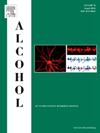Circulating microRNAs and alcohol consumption in the multiethnic cohort study
IF 2.9
4区 医学
Q3 PHARMACOLOGY & PHARMACY
引用次数: 0
Abstract
Excessive alcohol consumption is a significant public health concern and contributes to liver diseases and cancer. Modifiable lifestyle factors including alcohol consumption can influence circulating microRNAs (miRNAs), which are increasingly used as biomarkers for early disease detection. Yet limited studies have identified miRNAs associated with alcohol intake, particularly in multiethnic populations. We aimed to assess the association of alcohol consumption and circulating miRNAs in the Multiethnic Cohort Study. Participants (N = 917) had alcohol consumption data collected at baseline and miRNA data collected at follow-up. Negative binomial models were used to assess the association between alcohol consumption (continuous and categorical [nondrinkers: 0 g of ethanol/day; light drinkers: <28 g of ethanol/day for men and <14 g of ethanol/day for women; and heavy drinkers: ≥28 g of ethanol/day for men and ≥14 g of ethanol/day for women]) and miRNAs. Stratified analyses also examined categories by sex, race/ethnicity, smoking status, and body mass index. Overall, there were 52% non-drinkers, 37 % light drinkers, and 11 % were heavy drinkers. We did not detect an association of miRNAs with alcohol intake in continuous models after correcting for multiple comparisons. However, we did find an inverse association for light drinkers [incidence rate ratio (IRR) = 0.59, p = 8.21E-04] and heavy drinkers (IRR = 0.44, p = 1.47E-03) compared to nondrinkers for miR-451a. Additionally, miR-320e (IRR = 0.63, p = 1.61E-03) had an inverse association with alcohol intake for light drinkers compared to nondrinkers. Subgroup analysis also suggested there were differences by subgroups, underscoring that miRNAs used to detect chronic diseases may be subgroup specific. When stratified by case-control status, we found that among controls both light and heavy drinkers were associated with miR-451a. We identified an association for light and heavy drinkers with miR-451a and mir-320e, miRNAs associated with cancers and liver diseases, in comparison to nondrinkers.
多种族队列研究中的循环microrna与酒精消耗
过度饮酒是一个重大的公共卫生问题,会导致肝脏疾病和癌症。包括饮酒在内的可改变的生活方式因素可以影响循环中的microrna (mirna),而microrna越来越多地被用作早期疾病检测的生物标志物。然而,有限的研究已经确定了与酒精摄入相关的mirna,特别是在多种族人群中。我们的目的是在多种族队列研究中评估饮酒与循环mirna的关系。参与者(N = 917)在基线时收集酒精消耗数据,在随访时收集miRNA数据。使用负二项模型来评估酒精消耗(连续和分类)之间的关系[不饮酒者:0 g乙醇/天;光喝酒:
本文章由计算机程序翻译,如有差异,请以英文原文为准。
求助全文
约1分钟内获得全文
求助全文
来源期刊

Alcohol
医学-毒理学
CiteScore
4.60
自引率
4.30%
发文量
74
审稿时长
15.6 weeks
期刊介绍:
Alcohol is an international, peer-reviewed journal that is devoted to publishing multi-disciplinary biomedical research on all aspects of the actions or effects of alcohol on the nervous system or on other organ systems. Emphasis is given to studies into the causes and consequences of alcohol abuse and alcoholism, and biomedical aspects of diagnosis, etiology, treatment or prevention of alcohol-related health effects.
Intended for both research scientists and practicing clinicians, the journal publishes original research on the neurobiological, neurobehavioral, and pathophysiological processes associated with alcohol drinking, alcohol abuse, alcohol-seeking behavior, tolerance, dependence, withdrawal, protracted abstinence, and relapse. In addition, the journal reports studies on the effects alcohol on brain mechanisms of neuroplasticity over the life span, biological factors associated with adolescent alcohol abuse, pharmacotherapeutic strategies in the treatment of alcoholism, biological and biochemical markers of alcohol abuse and alcoholism, pathological effects of uncontrolled drinking, biomedical and molecular factors in the effects on liver, immune system, and other organ systems, and biomedical aspects of fetal alcohol spectrum disorder including mechanisms of damage, diagnosis and early detection, treatment, and prevention. Articles are published from all levels of biomedical inquiry, including the following: molecular and cellular studies of alcohol''s actions in vitro and in vivo; animal model studies of genetic, pharmacological, behavioral, developmental or pathophysiological aspects of alcohol; human studies of genetic, behavioral, cognitive, neuroimaging, or pathological aspects of alcohol drinking; clinical studies of diagnosis (including dual diagnosis), treatment, prevention, and epidemiology. The journal will publish 9 issues per year; the accepted abbreviation for Alcohol for bibliographic citation is Alcohol.
 求助内容:
求助内容: 应助结果提醒方式:
应助结果提醒方式:


